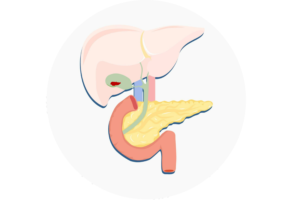Need Help?
We are here to help.
“Reach out to us for personalized care that puts your cancer worries to rest – Your journey to healing starts with us!”

 Gallbladder Cancer Causes are a cancer with low incidence and high mortality. While the cases of gall bladder cancer accounts for 1.2% of all cancer diagnoses, death because of it is 1.7% of all cancer deaths. By these figures we can see that gall bladder cancer is most deadly form of cancer. This is because only 1 of 10 gallbladder cancers is found in the early stages, and this cancer is very rapidly spreading kind of cancer; leading to poor survival rate. In this article we’ll understand the causes of gall bladder cancer and what is possible for its prevention.
Gallbladder Cancer Causes are a cancer with low incidence and high mortality. While the cases of gall bladder cancer accounts for 1.2% of all cancer diagnoses, death because of it is 1.7% of all cancer deaths. By these figures we can see that gall bladder cancer is most deadly form of cancer. This is because only 1 of 10 gallbladder cancers is found in the early stages, and this cancer is very rapidly spreading kind of cancer; leading to poor survival rate. In this article we’ll understand the causes of gall bladder cancer and what is possible for its prevention.
India has about 10% of the global Gallbladder cancer. Incidence is high in North, North-East, Central and Eastern India, and low in South India. Gallbladder cancer risk is seven times higher in the north and north-eastern states as compared with the south. Gall bladder cancer incidence is rising. Gallbladder cancer causes as advised by most oncologists treatting gallbladder cancer are summerized in three risk groups.
While the gallbladder is a small organ unessential for life, adenocarcinoma of the gallbladder is a deadly and often untreatable cancer. It is such a rapidly spreading malignancy that often could not be diagnosed until advanced stages, when life expectancy is only in several months despite treatment. 75% of these cases are preventable. Possibles ways of gallbladder cancer prevention includes:
Subscribe to get the latest posts sent to your email.
“Reach out to us for personalized care that puts your cancer worries to rest – Your journey to healing starts with us!”

Dr. Kaushal Yadav is a distinguished cancer surgeon whose unwavering dedication and expertise have illuminated the path of hope for countless patients battling cancer. With a career spanning several years, Dr. Yadav has treated countless patients with utmost dedication and has emerged as a beacon of hope in the fight against cancer.
He specializes in Breast Cancer, Lung Cancer, Esophagus Cancer, Colon & Rectum Cancer, Liver & Pancreas cancer, Gynae Cancer and Oral & Throat Cancer along with other cancer and highly complicated surgeries. Dr. Yadav’s multidisciplinary approach ensures safe and excellent outcomes for his patients. His work is recognized worldwide through his publications.o.